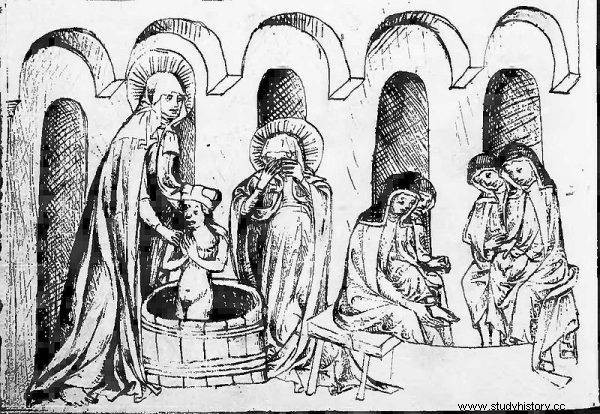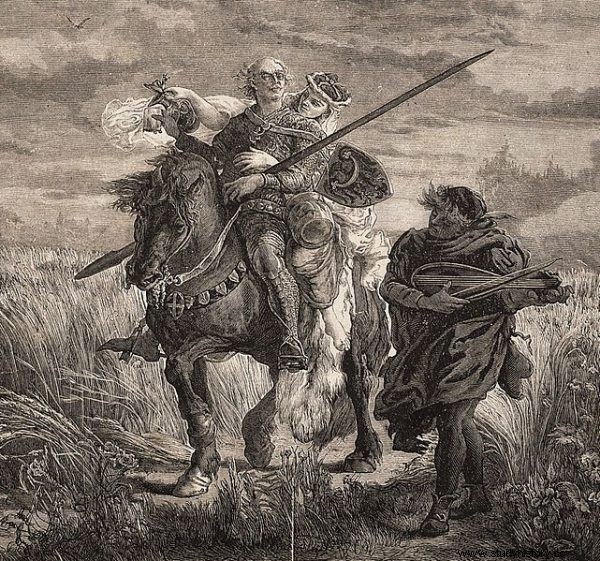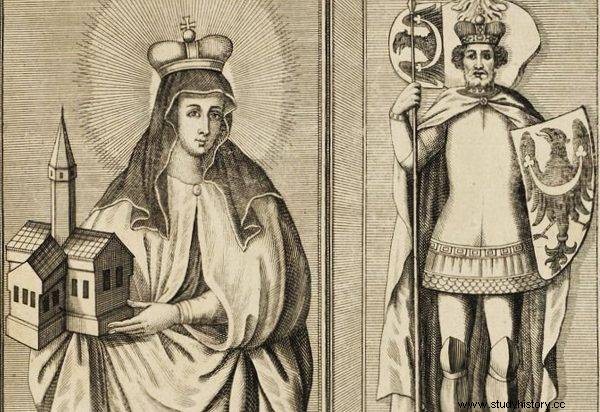No other ruler from the Piast era had so many children. Anna Przemyślidka was a record holder in this respect, but her role was not limited to giving birth.
With her mother-in-law, Jadwiga, famous for her ascetic practices, she found a common language. Despite her persuasions, she did not give up small pleasures (she especially liked the cheerful company of Poor Clares, with whom she sometimes dined). She also did not decide on a white marriage.
With Henryk Pious, they had twelve children, nine of whom lived to adulthood. However, apart from that, Jadwiga practically did not give way to funding monasteries, prayers and charity work.
Could Anna have become a saint?
After her husband's death, she changed her dignified robes for a monk's gray dress, cut her hair, and having fulfilled her last duty to Henry, which was to find his body on the battlefield (which, due to the decapitation of the ruler, was possible only due to the specific structure of the foot), stopped despair and rolled up her sleeves . And she had a lot of work.

The widow financed medicines and herbal tinctures for hospitals, sent clothes and food to shelters, and personally visited the centers under her care.
First of all, after the retreat of the Tatar troops, Silesia had to be rebuilt. Anna spared no funds especially for religious buildings. New monastery in Krzeszów? Here you are. Poor Clares in Wrocław? Why not.
Before her death, she even handed over her palace to the Order of Hospitallers. With a light hand, she distributed chasubles, chalices and other valuables in Prague, Rome and Marburg. The monastery in Trzebnica even received a relic - Saint Elizabeth's rib.
Read also:Hygiene of medieval queens. Did our rulers stink?
Good Duchess
In the thirteenth century, it was not unusual for rich and powerful families to manifest their own mercy. At Przemyślidka's table, there was often a blind man over whom she took care of. From the day of birth, she took care of the blind and made sure that they did not lack food and clothing.
The widow financed medicines and herbal tinctures for hospitals, shipped clothes and food to shelters, personally visited centers under her care . Interestingly, she continued to do so even when the disease prevented her from walking.
In the last years of her life, she fell on rheumatism, who took away her power in her limbs. She then ordered ... to be carried in a chair for the service . If it happened that she could not appear somewhere in person, she sent messengers with donations and food.
In the eyes of her family and subjects, Anna was no less godly than Jadwiga, but, unlike her mother-in-law, she never became a saint. On the one hand, no one made any special efforts to do so (in the case of Jadwiga, her daughter, Gertruda, applied for the initiation of the canonization process). On the other hand, Anna's reputation was overshadowed by the disputes with the Church ... by her son.
Read also:Devil in Piast's skin. Who was Bolesław Rogatka?
Unruly children of Przemyślidki
Depending on the source, he was 16 or 21 years old at the time of his father's death. Regardless of when the Hornet was actually born, history knows many younger rulers. Nevertheless, Anna exercised welfare government on his behalf for at least several months. Why?
First, Henry the Pious was extremely slow in teaching his sons politics, and no one expected his premature departure. Second, Bolesław himself was simply not fit to rule.

Already in childhood, his saintly grandmother predicted the misfortune that the Hornet would bring to the Silesian lands.
Already in childhood, his saintly grandmother predicted the misfortune that the Hornet would bring to the Silesian lands. Another Przemyślidka, brought up at the court in Prague, where the importance of well-born women grew. So, despite mourning, she took over on behalf of her son, and after the regency period ended, she continued to support him (as well as all the younger ones).
Read also:What were the births like in medieval Europe?
Lady in Silesia
In fact, some historians believe that Anna - with the support of the Wrocław bishop - ruled in Silesia for much longer, until 1248, and that Bolesław himself was only a figurehead not interested in politics.
Of course, as a woman, she could not do everything for him - on military expeditions, most often lost, after all, Rogatka traveled alone. However, the stamp of Przemyślidka (a woman in a long dress with tight sleeves) appeared on documents for years.

Anna Przemyślidka was one of the few Piast mothers who exercised real power.
The widow duchess gave her consent to the decisions of her adult children or acted as a witness. She took care of Polish-Czech relations personally. She was one of the few Piast mothers who exercised real power.
In the end, Anna did not manage to prevent the loss of land and the division of Silesia, but thanks to efficient politics, favor of the Holy See (consistently undermined by her eldest son) and authority among her family and subjects, she prevented many tragedies.
A hair from a catastrophe
Perhaps the biggest of them would be the implementation of the crusade that Archbishop Pełka announced against the Rogatka. This would entail the entry of troops into Silesia and the loss of the Duchy of Legnica.
To prevent this, the younger sons, most likely in agreement with their mother, kidnapped Bolesław and imprisoned him in the Wrocław castle. The prince stayed there until 1258, when the archbishop fell ill. There was no longer any reason to imprison Piast, so the brothers, again probably with maternal approval, let him escape.
Two years later the already aged duchess personally participated in the convention in Głogów, which ended some of Bolesław's problems with the Church . She was probably losing the use of her legs by then. She still had a photo of the excommunication from Rogatka. The poisoning of her two sons never lived. She died in June 1265, and her subjects considered her almost a saint.
Sources:
- Długosz J., Annals or Chronicles of the famous Kingdom of Poland , Warsaw 2009
- Faron B., Saints and tigers. Piastówny and the Piasts' wives 1138-1320 , Krakow 2018
- Book of Henryków [in:] Biblioteka.kijowski.pl [access:20/09/2021]
- Kruszyński T., Saint Jadwiga of Silesia and her sanctuary in Trzebnica [in:] "Collectanea Theologica" 28 / 3-4, Warsaw 1957
